Optimized Auxin and Cytokinin Interactions Enable Direct Somatic Embryogenesis in the Peach Rootstock ‘Guardian®’ from Immature Cotyledons
Abstract
1. Introduction
2. Results
2.1. Effect of PGRs on Somatic Embryogenesis Rate (SE %)
2.2. Effects of PGRs on SE Productivity
2.3. Effect of PGRs on Callogenesis Rate (Callus %)
2.4. Somatic Embryos Maturation, Germination and Acclimatization
3. Discussion
4. Materials and Methods
4.1. Plant Material and Execution of Inoculation of Explants
4.2. SE Induction
4.3. Parameters Selection and Recording
4.4. Maturation and Germination of SEs and Plant Acclimatization
4.5. Morphological Observations
4.6. Statistical Analysis
5. Conclusions
Author Contributions
Funding
Institutional Review Board Statement
Informed Consent Statement
Data Availability Statement
Acknowledgments
Conflicts of Interest
Abbreviations
| DSE | Direct somatic embryogenesis |
| SE | Somatic embryogenesis |
| 2,4-D | 2,4-dichlorophenoxyacetic acid |
| KIN | Kinetin |
| µM | One millionth of a mole per liter |
| ISE | Indirect somatic embryogenesis |
| BAP | 6-benzylaminopurine |
| PTSL | Peach tree short life |
| ARR | Armillaria root rot |
| QL | Quoirin and Lepoivre |
| MS | Murashige and Skoog |
| SEIM | Somatic embryogenesis induction media |
| PGRs | Plant Growth Regulators |
| DM | Differentiation media |
| NAA | 1-Naphthaleneacetic acid |
| ANOVA | Analysis of variance |
References
- Scorza, R.; Sherman, W. Peaches. In Fruit Breeding: Tree and Tropical Fruits; Janick, J., Jn, M., Eds.; John Wiley: New York, NY, USA, 1996; pp. 325–440. [Google Scholar]
- Verde, I.; Abbott, A.G.; Scalabrin, S.; Jung, S.; Shu, S.; Marroni, F.; Zhebentyayeva, T.; Dettori, M.T.; Grimwood, J.; Cattonaro, F.; et al. The high-quality draft genome of peach (Prunus persica) identifies unique patterns of genetic diversity, domestication and genome evolution. Nat. Genet. 2013, 45, 487–494. [Google Scholar] [CrossRef] [PubMed]
- Jelenkovic, G.; Harrington, E. Morphology of the pachytene chromosomes in Prunus persica. Can. J. Genet. Cytol. 1972, 14, 317–324. [Google Scholar] [CrossRef]
- Baird, W.V.; Estager, A.S.; Wells, J.K. Estimating Nuclear DNA Content in Peach and Related Diploid Species Using Laser Flow Cytometry and DNA Hybridization. J. Am. Soc. Hortic. Sci. 1994, 119, 1312–1316. [Google Scholar] [CrossRef]
- Pérez-Clemente, R.M.; Pérez-Sanjuán, A.; García-Férriz, L.; Beltrán, J.-P.; Cañas, L.A. Transgenic peach plants (Prunus persica L.) produced by genetic transformation of embryo sections using the green fluorescent protein (GFP) as an in vivo marker. Mol. Breed. 2004, 14, 419–427. [Google Scholar] [CrossRef]
- Kangben, F.; Kumar, S.; Li, Z.; Sreedasyam, A.; Dardick, C.; Jones, D.; Saski, C.A. Phylogenetic and functional analysis of tiller angle control homeologs in allotetraploid cotton. Front. Plant Sci. 2023, 14, 1320638. [Google Scholar] [CrossRef] [PubMed]
- Dardick, C.; Callahan, A.; Horn, R.; Ruiz, K.B.; Zhebentyayeva, T.; Hollender, C.; Whitaker, M.; Abbott, A.; Scorza, R. PpeTAC1 promotes the horizontal growth of branches in peach trees and is a member of a functionally conserved gene family found in diverse plants species. Plant J. 2013, 75, 618–630. [Google Scholar] [CrossRef]
- Liu, J.; Bennett, D.; Demuth, M.; Burchard, E.; Artlip, T.; Dardick, C.; Liu, Z. euAP2a, a key gene that regulates flowering time in peach (Prunus persica) by modulating thermo-responsive transcription programming. Hortic. Res. 2024, 11, uhae076. [Google Scholar] [CrossRef]
- Berman, A.; Su, N.; Li, Z.; Landau, U.; Chakraborty, J.; Gerbi, N.; Liu, J.; Qin, Y.; Yuan, B.; Wei, W.; et al. Construction of multi-targeted CRISPR libraries in tomato to overcome functional redundancy at genome-scale level. Nat. Commun. 2025, 16, 4111. [Google Scholar] [CrossRef]
- Yu, Y.; Guan, J.; Xu, Y.; Ren, F.; Zhang, Z.; Yan, J.; Fu, J.; Guo, J.; Shen, Z.; Zhao, J.; et al. Population-scale peach genome analyses unravel selection patterns and biochemical basis underlying fruit flavor. Nat. Commun. 2021, 12, 3604. [Google Scholar] [CrossRef]
- Mas-Gómez, J.; Cantín, C.M.; Moreno, M.; Martínez-García, P.J. Genetic Diversity and Genome-Wide Association Study of Morphological and Quality Traits in Peach Using Two Spanish Peach Germplasm Collections. Front. Plant Sci. 2022, 13, 854770. [Google Scholar] [CrossRef]
- Calle, A.; Saski, C.; Wünsch, A.; Grimplet, J.; Gasic, K. Identification of Key Genes Related to Dormancy Control in Prunus Species by Meta-Analysis of RNAseq Data. Plants 2022, 11, 2469. [Google Scholar] [CrossRef] [PubMed]
- Su, Z.; Jia, H.; Sun, M.; Cai, Z.; Shen, Z.; Zhao, B.; Li, J.; Ma, R.; Yu, M.; Yan, J. Integrative analysis of the metabolome and transcriptome reveals the molecular mechanism of chlorogenic acid synthesis in peach fruit. Front. Nutr. 2022, 9, 961626. [Google Scholar] [CrossRef] [PubMed]
- Nilo-Poyanco, R.; Moraga, C.; Benedetto, G.; Orellana, A.; Almeida, A.M. Shotgun proteomics of peach fruit reveals major metabolic pathways associated to ripening. BMC Genom. 2021, 22, 17. [Google Scholar] [CrossRef] [PubMed]
- Lurie, S. Proteomic and metabolomic studies on chilling injury in peach and nectarine. Front. Plant Sci. 2022, 13, 958312. [Google Scholar] [CrossRef] [PubMed]
- Cao, K.; Wang, B.; Fang, W.; Zhu, G.; Chen, C.; Wang, X.; Li, Y.; Wu, J.; Tang, T.; Fei, Z.; et al. Combined nature and human selections reshaped peach fruit metabolome. Genome Biol. 2022, 23, 146. [Google Scholar] [CrossRef]
- Humberto, P. Genetic Transformation Strategies in Fruit Crops. In Genetic Transformation; María, A., Ed.; IntechOpen: Rijeka, Croatia, 2011. [Google Scholar]
- Druart, P. Somatic Embryogenesis in Prunus species. In Somatic Embryogenesis in Woody Plants: Volume 5; Jain, S.M., Gupta, P.K., Newton, R.J., Eds.; Springer: Dordrecht, The Netherlands, 1999; pp. 215–235. [Google Scholar]
- Srinivasan, C.; Padilla, I.; Scorza, R. Prunus spp. Almond, Apricot, Cherry, Nectarine, Peach and Plum; CABI: Wallingford, UK, 2005; pp. 512–542. [Google Scholar] [CrossRef]
- Srinivasan, C.; Scorza, R. Transformation of Somatic Embryos of Fruit Trees and Grapevine. In Somatic Embryogenesis in Woody Plants: Volume 5; Jain, S.M., Gupta, P.K., Newton, R.J., Eds.; Springer: Dordrecht, The Netherlands, 1999; pp. 313–330. [Google Scholar]
- Gao, M.; Kawabe, M.; Tsukamoto, T.; Hanada, H.; Tao, R. Somatic embryogenesis and Agrobacterium-mediated transformation of Japanese apricot (Prunus mume) using immature cotyledons. Sci. Hortic. 2010, 124, 360–367. [Google Scholar] [CrossRef]
- Rugini, E. Somatic embryogenesis and plant regeneration in olive (Olea europaea L.). Plant Cell Tissue Organ Cult. 1988, 14, 207–214. [Google Scholar] [CrossRef]
- Sánchez-Romero, C. Somatic Embryogenesis in Olive. Plants 2021, 10, 433. [Google Scholar] [CrossRef]
- Kumar, S.; Ruggles, A.; Logan, S.; Mazarakis, A.; Tyson, T.; Bates, M.; Grosse, C.; Reed, D.; Li, Z.; Grimwood, J.; et al. Comparative Transcriptomics of Non-Embryogenic and Embryogenic Callus in Semi-Recalcitrant and Non-Recalcitrant Upland Cotton Lines. Plants 2021, 10, 1775. [Google Scholar] [CrossRef]
- Cuenca, B.; San-José, M.C.; Martínez, M.T.; Ballester, A.; Vieitez, A.M. Somatic embryogenesis from stem and leaf explants of Quercus robur L. Plant Cell Rep. 1999, 18, 538–543. [Google Scholar] [CrossRef]
- Ikeda-Iwai, M.; Satoh, S.; Kamada, H. Cell and Molecular Biology, Biochemistry and Molecular Physiology-Establishment of a reproducible tissue culture system for the induction of Arabidopsis somatic embryos. J. Exp. Bot. 2002, 53, 1575–1580. [Google Scholar] [CrossRef]
- Montalbán, I.; De Diego, N.; Moncaleán, P. Enhancing initiation and proliferation in radiata pine (Pinus radiata D. Don) somatic embryogenesis through seed family screening, zygotic embryo staging and media adjustments. Acta Physiol. Plant. 2012, 34, 451–460. [Google Scholar] [CrossRef]
- Corredoira, E.; Ballester, A.; Ibarra, M.; Vieitez, A.M. Induction of somatic embryogenesis in explants of shoot cultures established from adult Eucalyptus globulus and E. saligna × E. maidenii trees. Tree Physiol. 2015, 35, 678–690. [Google Scholar] [CrossRef]
- Leva, A.; Muleo, R.M.; Petruccelli, R. Long-term somatic embryogenesis from immature olive cotyledons. J. Hortic. Sci. 1995, 70, 417–421. [Google Scholar] [CrossRef]
- Ricci, A.; Sabbadini, S.; Prieto, H.; Padilla, I.M.; Dardick, C.; Li, Z.; Scorza, R.; Limera, C.; Mezzetti, B.; Perez-Jimenez, M.; et al. Genetic Transformation in Peach (Prunus persica L.): Challenges and Ways Forward. Plants 2020, 9, 971. [Google Scholar] [CrossRef] [PubMed]
- Srinivasan, C.; Scorza, R. The influence of genotype on the induction of somatic embryos from in vitro cultured zygotic embryos and adventitious shoot regeneration from cotyledons of peach and nectarine. Acta Hortic. 2007, 738, 691–696. [Google Scholar] [CrossRef]
- Hammerschlag, F.A.; Bauchan, G.; Scorza, R. Regeneration of peach plants from callus derived from immature embryos. Theor. Appl. Genet. 1985, 70, 248–251. [Google Scholar] [CrossRef]
- Bhansali, R.; Driver, J.; Durzan, D.J. Somatic embryogenesis in cell suspension cultures of Prunus persica (L.). J. Hortic. Sci. 1991, 66, 601–605. [Google Scholar] [CrossRef]
- Capriotti, L.; Limera, C.; Mezzetti, B.; Ricci, A.; Sabbadini, S. From induction to embryo proliferation: Improved somatic embryogenesis protocol in grapevine for Italian cultivars and hybrid Vitis rootstocks. Plant Cell Tissue Organ Cult. 2022, 151, 221–233. [Google Scholar] [CrossRef]
- Méndez-Hernández, H.A.; Ledezma-Rodríguez, M.; Avilez-Montalvo, R.N.; Juárez-Gómez, Y.L.; Skeete, A.; Avilez-Montalvo, J.; De-la-Peña, C.; Loyola-Vargas, V.M. Signaling Overview of Plant Somatic Embryogenesis. Front. Plant Sci. 2019, 10, 77. [Google Scholar] [CrossRef] [PubMed]
- Singh, P.; Sinha, A.K. Interplay Between Auxin and Cytokinin and Its Impact on Mitogen Activated Protein Kinase (MAPK). In Auxins and Cytokinins in Plant Biology: Methods and Protocols; Dandekar, T., Naseem, M., Eds.; Springer: New York, NY, USA, 2017; pp. 93–100. [Google Scholar]
- Bhansali, R.R.; Driver, J.A.; Durzan, D.J. Rapid multiplication of adventitious somatic embryos in peach and nectarine by secondary embryogenesis. Plant Cell Rep. 1990, 9, 280–284. [Google Scholar] [CrossRef]
- Maillot, P.; Deglène-Benbrahim, L.; Walter, B. Efficient somatic embryogenesis from meristematic explants in grapevine (Vitis vinifera L.) cv. Chardonnay: An improved protocol. Trees 2016, 30, 1377–1387. [Google Scholar] [CrossRef]
- Sidek, N.; Nulit, R.; Kong, Y.C.; Yien, C.Y.S.; Sekeli, R.; El-Barghathi, M.F. Callogenesis and somatic embryogenesis of Oryza sativa L. (cv. MARDI Siraj 297) under the influence of 2, 4-dichlorophenoxyacetic acid and kinetin. AIMS Agric. Food 2022, 7, 536–552. [Google Scholar] [CrossRef]
- Abohatem, M.; Zouine, J.; El Hadrami, I. Low concentrations of BAP and high rate of subcultures improve the establishment and multiplication of somatic embryos in date palm suspension cultures by limiting oxidative browning associated with high levels of total phenols and peroxidase activities. Sci. Hortic. 2011, 130, 344–348. [Google Scholar] [CrossRef]
- Beckman, T.G.; Okie, W.R.; Nyczepir, A.P.; Reighard, G.L.; Zehr, E.I.; Newall, W.C. History, current status and future potential of guardiantm (BY520-9) peach rootstock. Acta Hortic. 1997, 451, 251–258. [Google Scholar] [CrossRef]
- Okie, W.R.; Beckman, T.G.; Nyczepir, A.P.; Reighard, G.L.; Newall, W.C.; Zehr, E.I. BY520-9, A Peach Rootstock for the Southeastern United States that Increases Scion Longevity. HortScience 1994, 29, 705–706. [Google Scholar] [CrossRef]
- Weaver, T. A Guardian Angel for Peach Trees. Agric. Res. 1998, 46, 10–11. [Google Scholar]
- San, B.; Li, Z.; Hu, Q.; Reighard, G.L.; Luo, H. Adventitious shoot regeneration from in vitro cultured leaf explants of peach rootstock Guardian® is significantly enhanced by silver thiosulfate. Plant Cell Tissue Organ Cult. 2015, 120, 757–765. [Google Scholar] [CrossRef]
- Meng, X.; Zhou, W. Induction of embroid and production of plantlets in vitro from endosperm of peach. Acta Agric. Univ. Pekin. 1981, 7, 95–98. [Google Scholar]
- Scorza, R.; Morgens, P.H.; Cordts, J.M.; Mante, S.; Callahan, A.M. Agrobacterium-Mediated Transformation of Peach (Prunus persica L. Batsch) Leaf Segments, Immature Embryos, and Long-Term Embryogenic Callus. In Vitro Cell. Dev. Biol. 1990, 26, 829–834. [Google Scholar] [CrossRef]
- Mante, S.; Scorza, R.; Cordts, J.M. Plant regeneration from cotyledons of Prunus persica, Prunus domestica, and Prunus cerasus. Plant Cell Tissue Organ Cult. 1989, 19, 1–11. [Google Scholar] [CrossRef]
- Pooler, M.R.; Scorza, R. Regeneration of Peach [Prunus persica (L.) Batsch] Rootstock Cultivars from Cotyledons of Mature Stored Seed. HortScience 1995, 30, 355–356. [Google Scholar] [CrossRef]
- Gentile, A.; Monticelli, S.; Damiano, C. Adventitious shoot regeneration in peach [Prunus persica (L.) Batsch]. Plant Cell Rep. 2002, 20, 1011–1016. [Google Scholar] [CrossRef]
- Zhang, M.; Wang, A.; Qin, M.; Qin, X.; Yang, S.; Su, S.; Sun, Y.; Zhang, L. Direct and Indirect Somatic Embryogenesis Induction in Camellia oleifera Abel. Front. Plant Sci. 2021, 12, 644389. [Google Scholar] [CrossRef]
- Chen, J.-T.; Su, Y.J.; Wu, I.F.; Chueh, C.M.; Kuo, H.L.; Chang, W.C. Somatic embryogenesis in Oncidium. Acta Hortic. 2005, 692, 81–84. [Google Scholar] [CrossRef]
- Nolan, K.E.; Irwanto, R.R.; Rose, R.J. Auxin Up-Regulates MtSERK1 Expression in Both Medicago truncatula Root-Forming and Embryogenic Cultures. Plant Physiol. 2003, 133, 218–230. [Google Scholar] [CrossRef]
- Ma, G.; Wu, G.; Bunn, E. Somatic embryogenesis and adventitious shoot formation in Burma reed (Neyraudia arundinacea Henr.). In Vitro Cell. Dev. Biol. Plant 2007, 43, 16–20. [Google Scholar] [CrossRef]
- Zavattieri, M.A.; Frederico, A.M.; Lima, M.; Sabino, R.; Arnholdt-Schmitt, B. Induction of somatic embryogenesis as an example of stress-related plant reactions. Electron. J. Biotechnol. 2010, 13, 12–13. [Google Scholar] [CrossRef]
- Adelberg, J.; Naylor-Adelberg, J.; Miller, S.; Gasic, K.; Schnabel, G.; Bryson, P.; Saski, C.; Parris, S.; Reighard, G. In vitro co-culture system for Prunus spp. and Armillaria mellea in phenolic foam rooting matric. In Vitro Cell. Dev. Biol. Plant 2021, 57, 387–397. [Google Scholar] [CrossRef]
- Lawson, J.D.; Bridges, W.C.; Adelberg, J.W. IBA Delivery Technique and Media Salts Affected In Vitro Rooting and Acclimatization of Eight Prunus Genotypes. Plants 2023, 12, 289. [Google Scholar] [CrossRef]
- von Arnold, S.; Sabala, I.; Bozhkov, P.; Dyachok, J.; Filonova, L. Developmental pathways of somatic embryogenesis. Plant Cell Tissue Organ. Cult. 2002, 69, 233–249. [Google Scholar] [CrossRef]
- Quoirin, M.; Lepoivre, P. Improved media for in vitro culture of Prunus sp. Acta Hortic. 1977, 78, 437–442. [Google Scholar] [CrossRef]
- Murashige, T.; Skoog, F. A Revised Medium for Rapid Growth and Bio Assays with Tobacco Tissue Cultures. Physiol. Plant. 1962, 15, 473–497. [Google Scholar] [CrossRef]
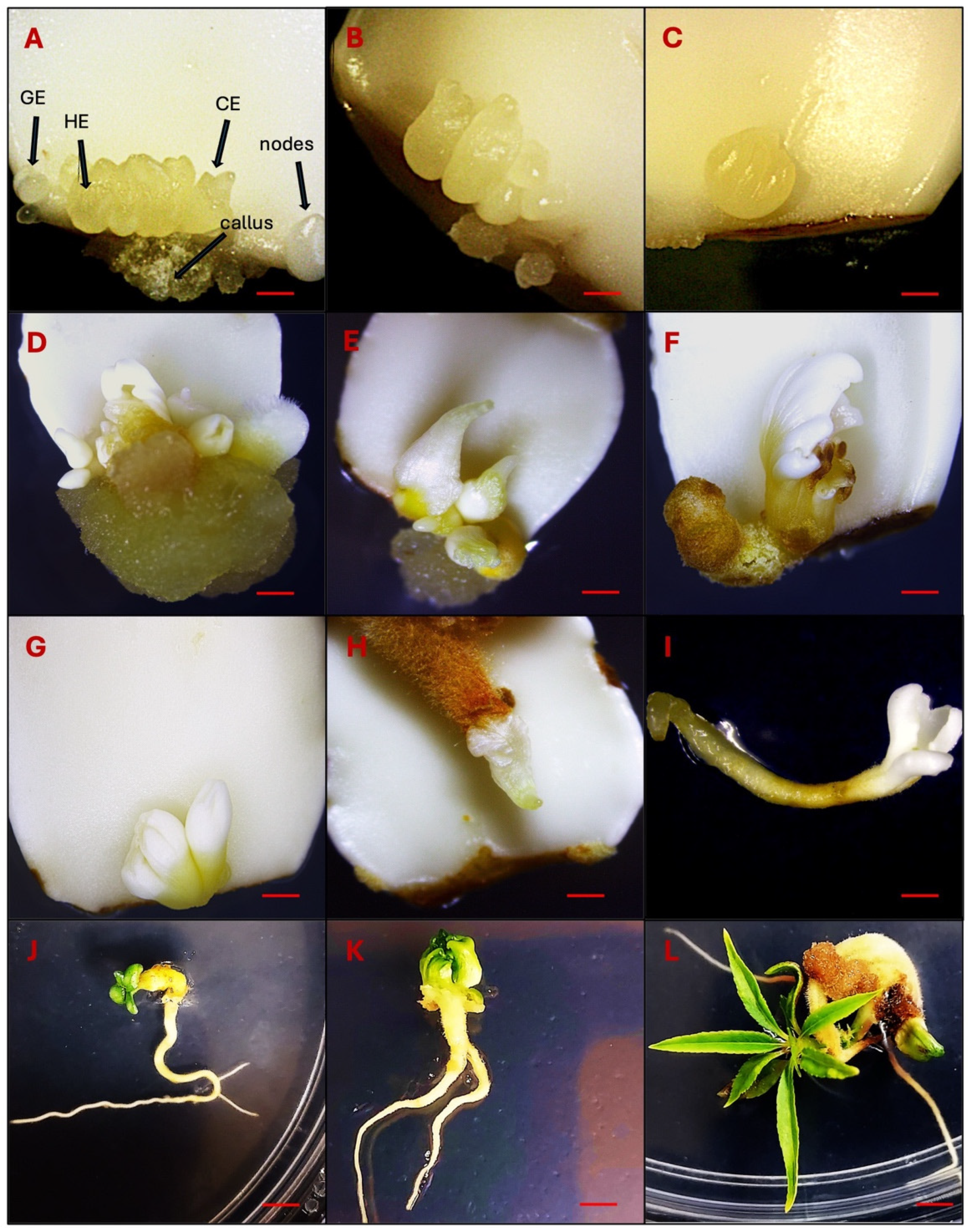
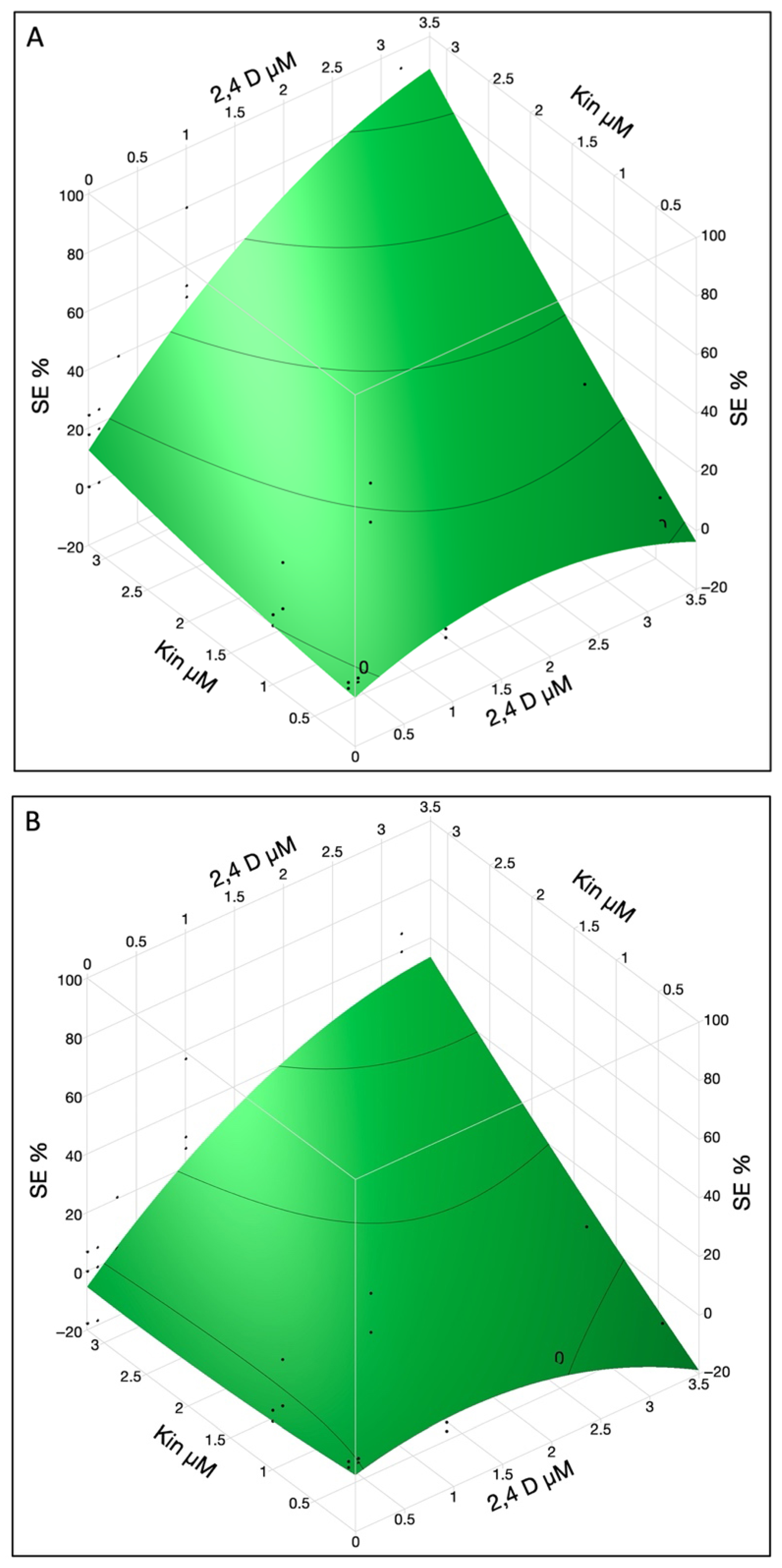
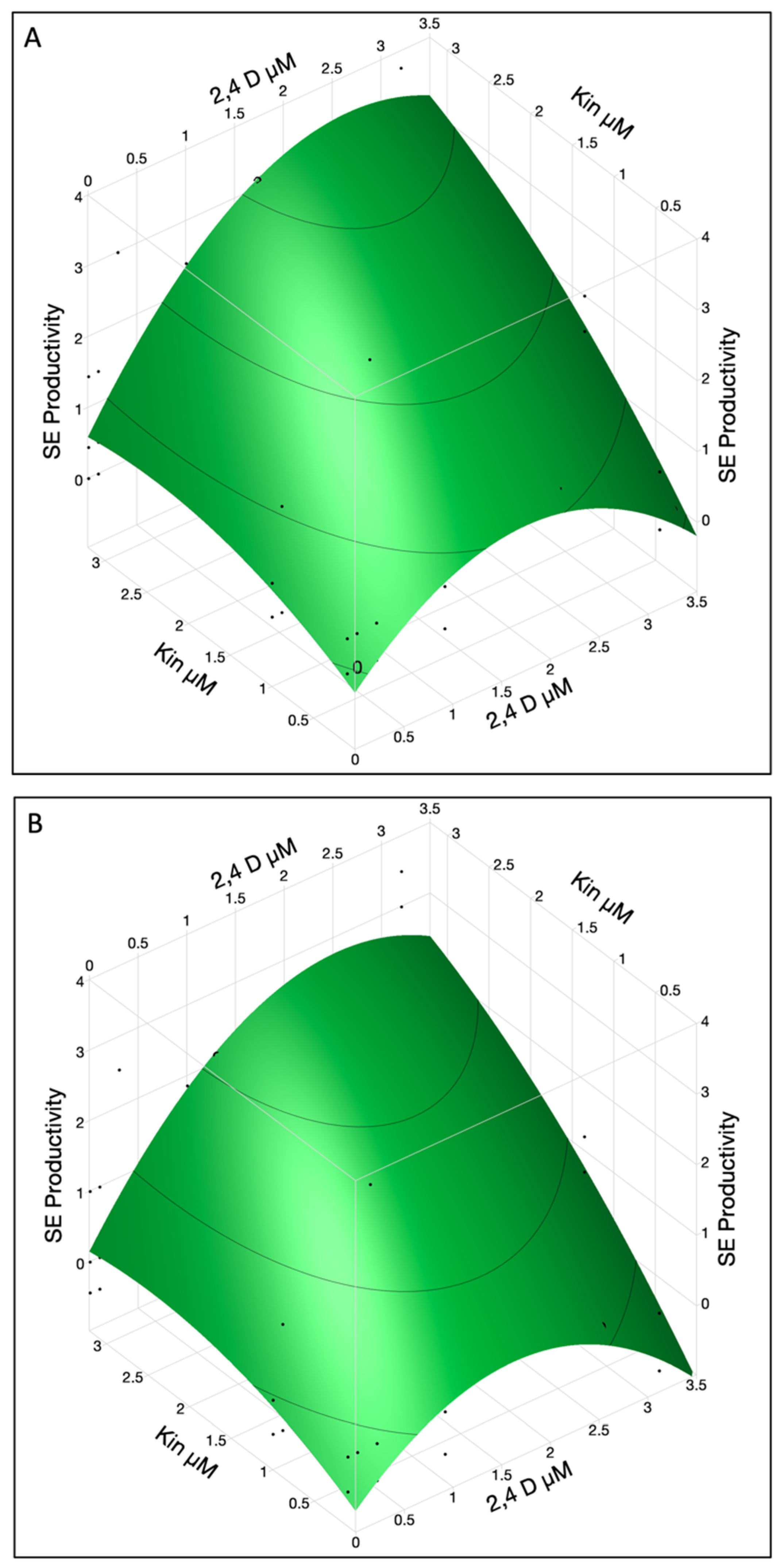


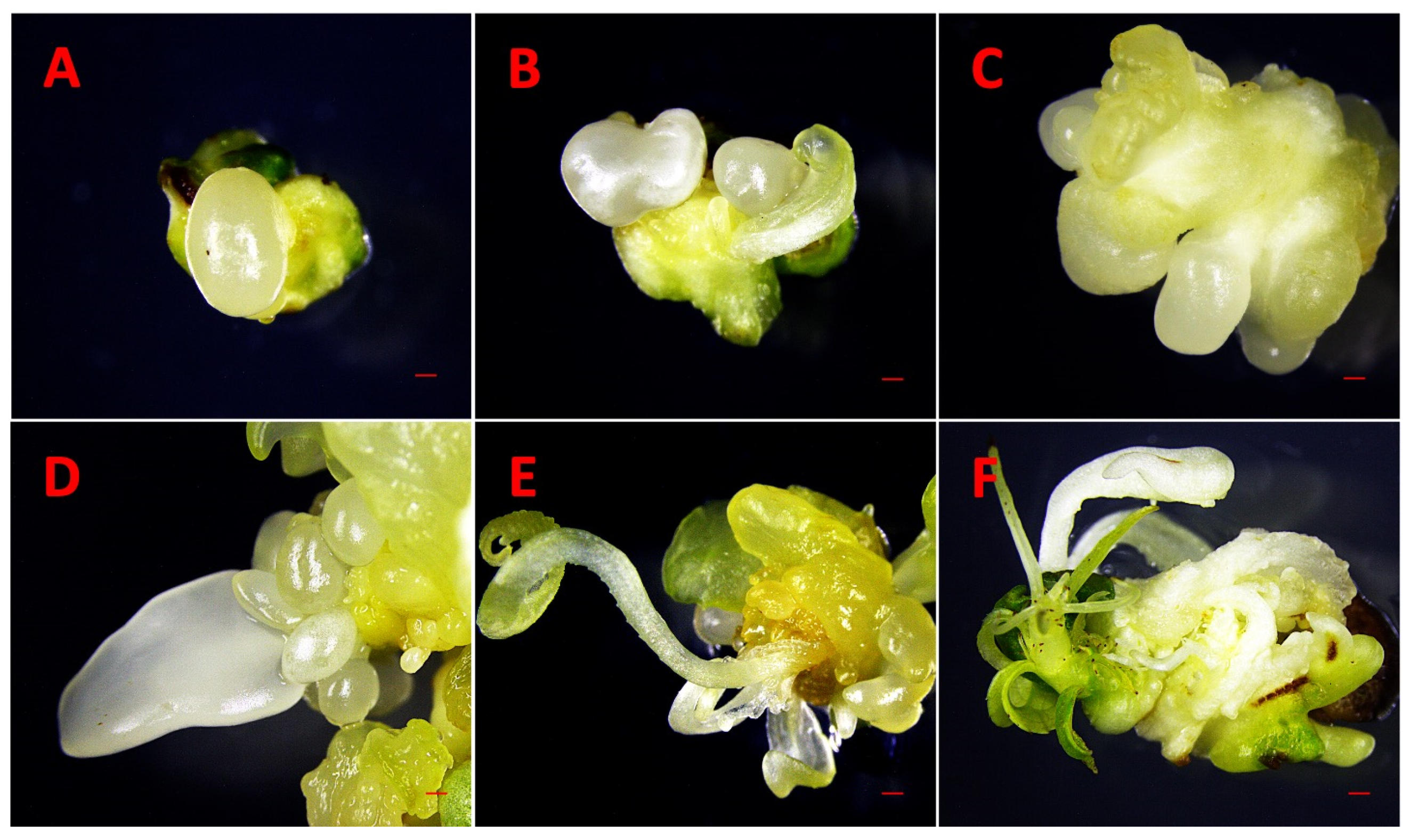
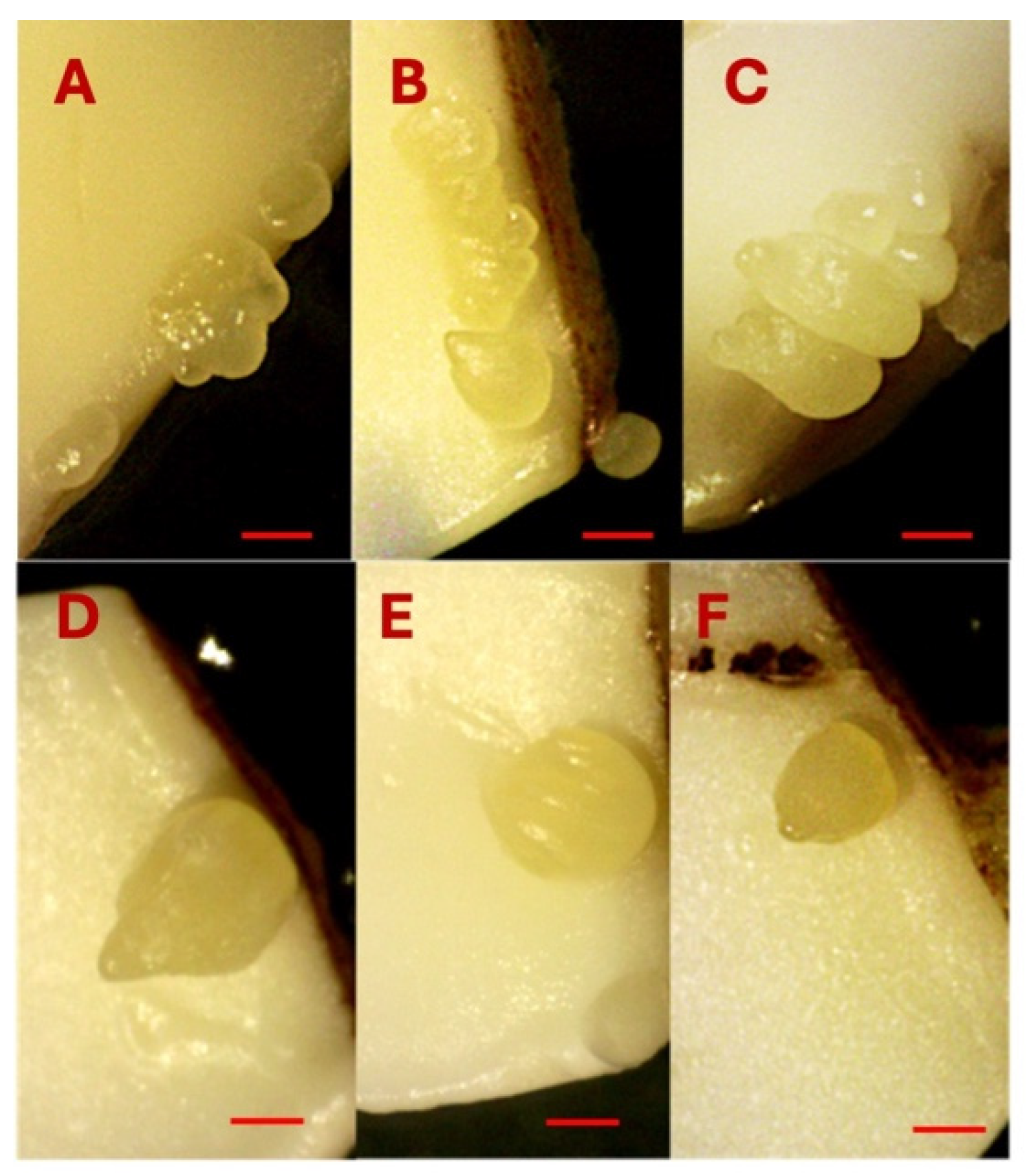
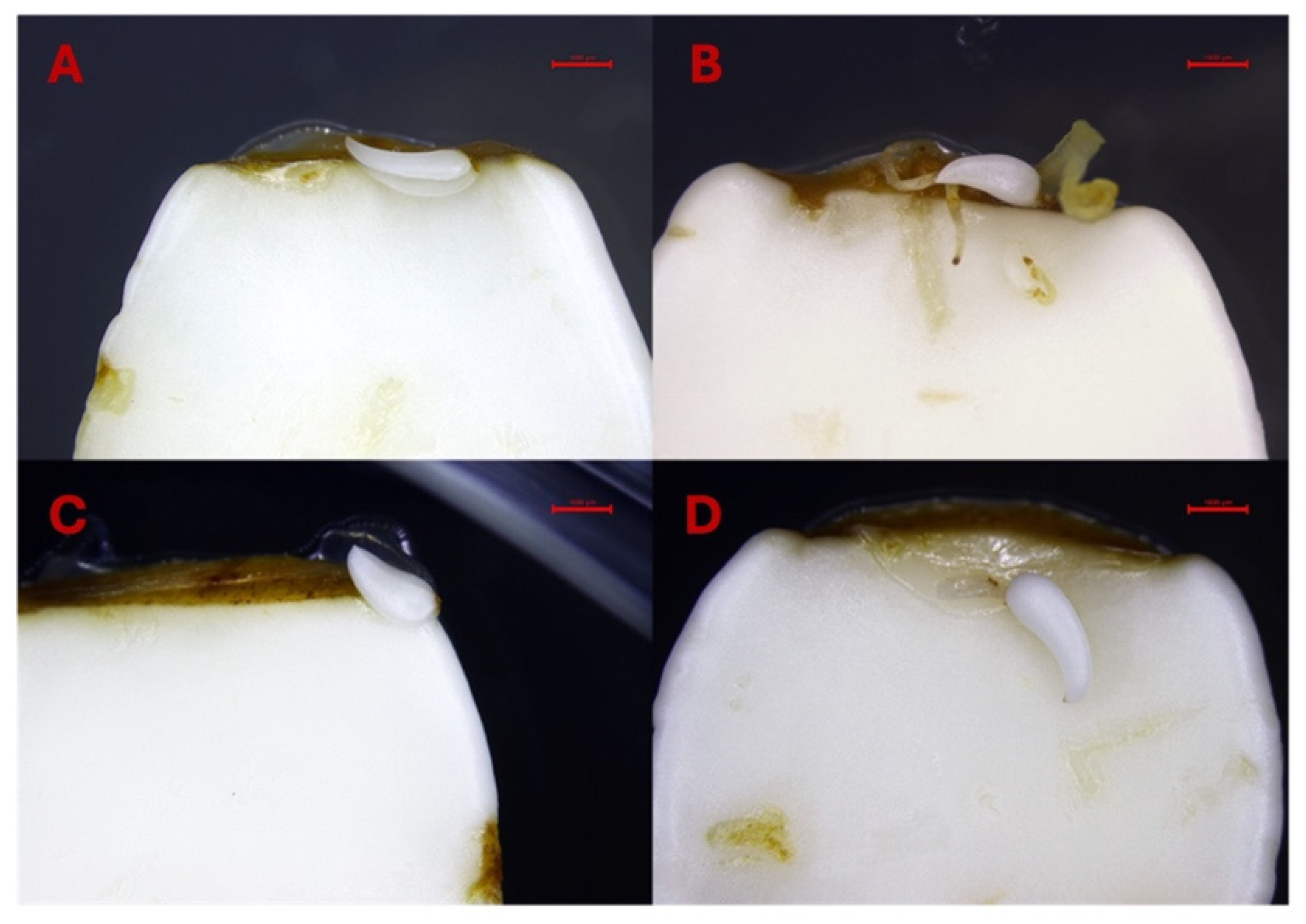

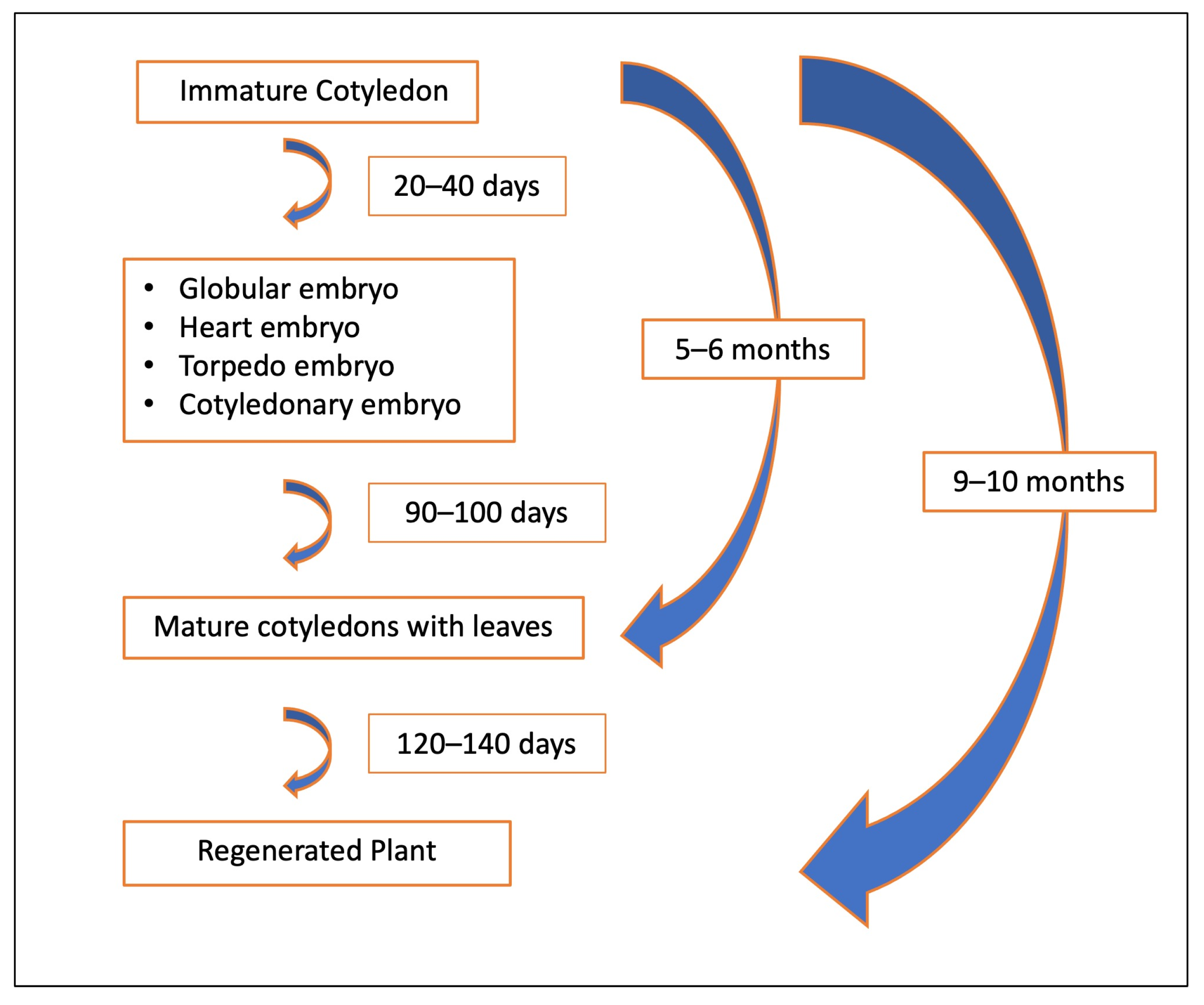
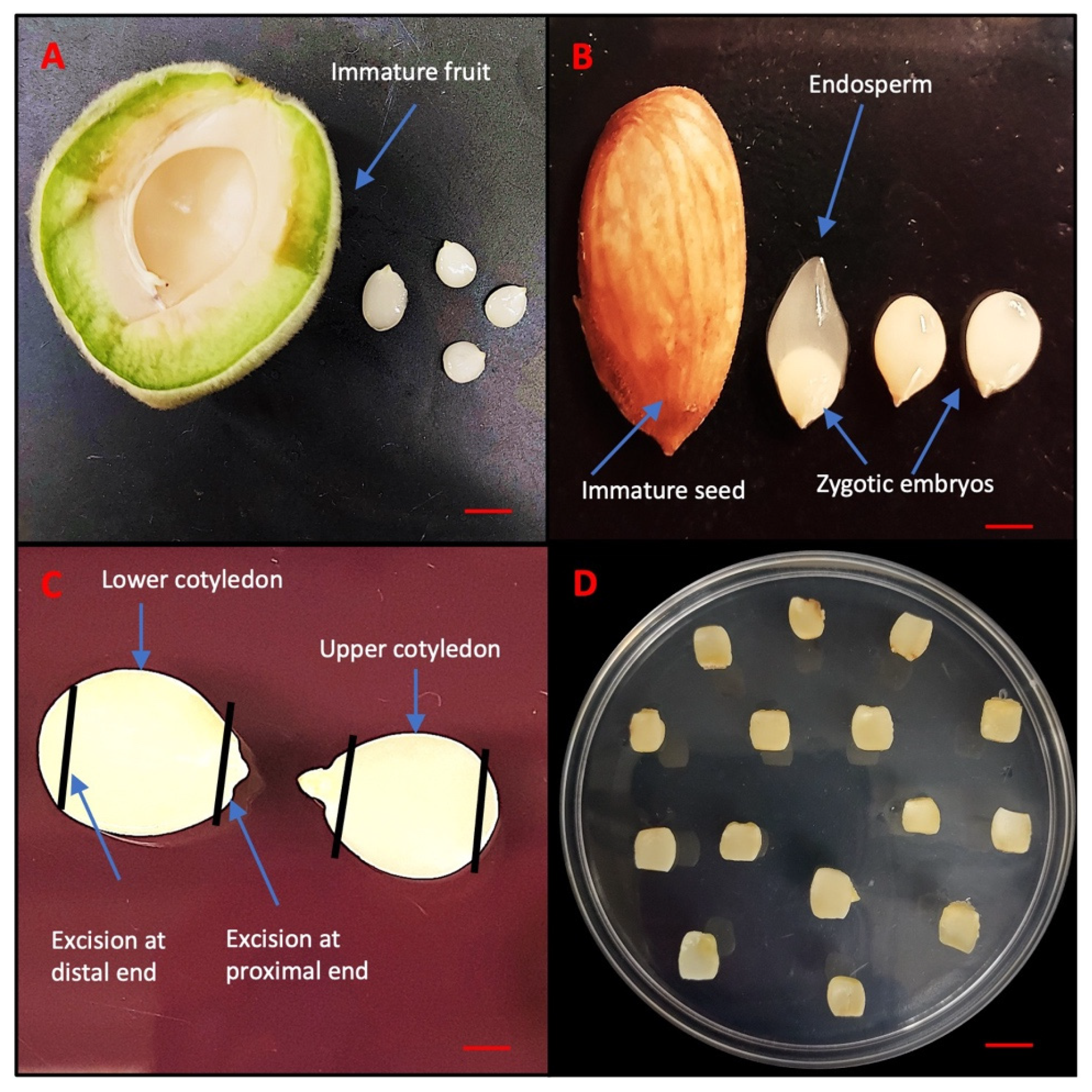
| Run | 2,4-D (µM) | KIN (µM) |
|---|---|---|
| 1 | 0.01 | 0.1 |
| 2 | 0.1 | |
| 3 | 0.3 | |
| 4 | 1 | |
| 5 | 3.2 | |
| 6 | 0.01 | 1 |
| 7 | 0.1 | |
| 8 | 0.3 | |
| 9 | 1 | |
| 10 | 3.2 | |
| 11 | 0.01 | 3.2 |
| 12 | 0.1 | |
| 13 | 0.3 | |
| 14 | 1 | |
| 15 | 3.2 |
| (A) Trait-SE % (RSquare = 0.81; RSquare Adjusted = 0.78) | |||
| Terms | Estimate | Mean Square | Prob > |t| |
| 2,4-D × KIN | 6.890537 | 6866.6806 | <0.0001 *** |
| KIN | 7.87553 | 3612.4906 | <0.0001 *** |
| 2,4-D | 13.93409 | 3046.5154 | <0.0001 *** |
| cotyledon location | −5.555556 | 1851.8519 | 0.0001 *** |
| KIN × cotyledon location | −3.193534 | 1037.5438 | 0.0031 ** |
| 2,4-D × 2,4-D | −4.108578 | 679.4956 | 0.0152 * |
| 2,4-D × cotyledon location | −2.50891 | 536.9068 | 0.0300 * |
| (B) Trait-SE productivity (RSquare = 0.52; RSquare Adjusted = 0.44) | |||
| Terms | Estimate | Mean Square | Prob > |t| |
| KIN | 0.514562 | 15.421375 | 0.0001 *** |
| 2,4-D | 0.956029 | 14.341305 | 0.0002 *** |
| 2,4-D × KIN | 0.23283 | 7.840062 | 0.0050 ** |
| 2,4-D × 2,4-D | −0.408734 | 6.724904 | 0.0089 ** |
| cotyledon location | −0.281667 | 4.760167 | 0.0264 * |
| (C) Trait-Callus % (RSquare = 0.84; RSquare Adjusted = 0.82) | |||
| Terms | Estimate | Mean Square | Prob > |t| |
| 2,4-D | 40.17464 | 25,325.053 | <0.0001 *** |
| cotyledon location | −16.66667 | 16,666.667 | <0.0001 *** |
| 2,4-D × 2,4-D | −13.92445 | 7804.766 | <0.0001 *** |
| KIN | 7.674595 | 3430.506 | 0.0004 *** |
| KIN × cotyledon location | −4.836173 | 2379.397 | 0.0025 ** |
| 2,4-D × KIN | −2.698459 | 1053.107 | 0.0390 * |
Disclaimer/Publisher’s Note: The statements, opinions and data contained in all publications are solely those of the individual author(s) and contributor(s) and not of MDPI and/or the editor(s). MDPI and/or the editor(s) disclaim responsibility for any injury to people or property resulting from any ideas, methods, instructions or products referred to in the content. |
© 2025 by the authors. Licensee MDPI, Basel, Switzerland. This article is an open access article distributed under the terms and conditions of the Creative Commons Attribution (CC BY) license (https://creativecommons.org/licenses/by/4.0/).
Share and Cite
Kumar, S.; El-Hawaz, R.; Li, Z.; Lawson, J.; Parris, S.; Kangben, F.; Carneal, L.; Hopkins, J.; Naylor-Adelberg, J.; Adelberg, J.; et al. Optimized Auxin and Cytokinin Interactions Enable Direct Somatic Embryogenesis in the Peach Rootstock ‘Guardian®’ from Immature Cotyledons. Int. J. Mol. Sci. 2025, 26, 8698. https://doi.org/10.3390/ijms26178698
Kumar S, El-Hawaz R, Li Z, Lawson J, Parris S, Kangben F, Carneal L, Hopkins J, Naylor-Adelberg J, Adelberg J, et al. Optimized Auxin and Cytokinin Interactions Enable Direct Somatic Embryogenesis in the Peach Rootstock ‘Guardian®’ from Immature Cotyledons. International Journal of Molecular Sciences. 2025; 26(17):8698. https://doi.org/10.3390/ijms26178698
Chicago/Turabian StyleKumar, Sonika, Rabia El-Hawaz, Zhigang Li, John Lawson, Stephen Parris, Foster Kangben, Lauren Carneal, Jeff Hopkins, Jacqueline Naylor-Adelberg, Jeffrey Adelberg, and et al. 2025. "Optimized Auxin and Cytokinin Interactions Enable Direct Somatic Embryogenesis in the Peach Rootstock ‘Guardian®’ from Immature Cotyledons" International Journal of Molecular Sciences 26, no. 17: 8698. https://doi.org/10.3390/ijms26178698
APA StyleKumar, S., El-Hawaz, R., Li, Z., Lawson, J., Parris, S., Kangben, F., Carneal, L., Hopkins, J., Naylor-Adelberg, J., Adelberg, J., Reighard, G., Gasic, K., Carr, C., III, & Saski, C. A. (2025). Optimized Auxin and Cytokinin Interactions Enable Direct Somatic Embryogenesis in the Peach Rootstock ‘Guardian®’ from Immature Cotyledons. International Journal of Molecular Sciences, 26(17), 8698. https://doi.org/10.3390/ijms26178698








